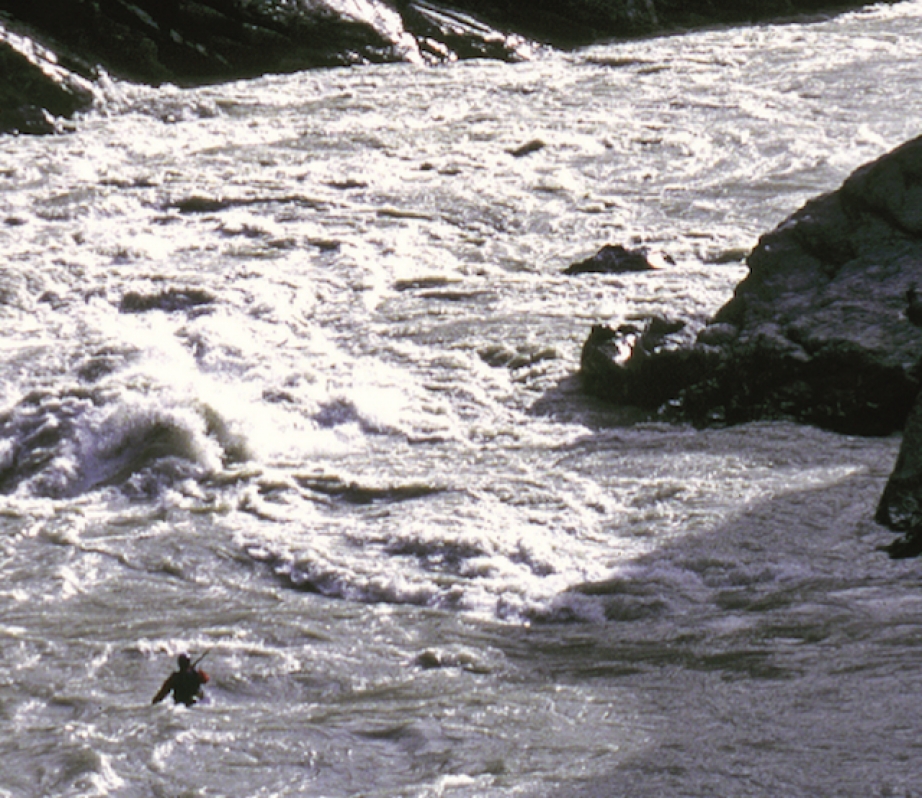I’ve just returned from scouting what I believe to be the fifth first descent of a tributary to the Bonnechere River.
Fifteen years ago, I dragged along a local “old guy” when I first scouted the creek. He didn’t tell me he’d run it a generation earlier. Like him, I haven’t the heart to tell this new crop of keeners that i’ve run it before.
A quiet Ottawa Valley canoe tripping river for most of the year, the Bonnechere booms in spring high water, fed by several feet of snow melt. This unnamed tributary enters above Basin Depot and drains the southeast corner of Algonquin Park. An eight-minute run with a window of just a couple of days a year, the creek packs continuous class III rapids and a couple 20-foot falls.
Before people paddled for recreation and adventure, a first descent was merely a means to an end
Fur, gold, logs and mapping the borders of a growing colony brought industry-minded paddlers to nearly all of the continent’s rivers one or two hundred years ago.
Early explorers such as Alexander MacKenzie, David Thompson and Simon Fraser left their names on newly “discovered” rivers, but it’s unlikely they bagged first descents on these waters. Native guides whose ancestors had used the river corridors for thousands of years led these European explorers. Even our first descent tributary to the Bonnechere has been thoroughly modified for log drives that ended 70 years ago.
Unlike Sir Edmund Hillary and Neil Armstrong, our river running forefathers tended not to plant a flag on the summit of their accomplishments. Assuming natives, fur traders, gold miners, log drivers or surveyors didn’t travel it earlier, there is little way of knowing who was first down a river.
The difficulty of proving a first descent doesn’t mean there’s no such thing.
Three examples of indisputable first descents stand out in our collective whitewater history
The granddaddy of them all, and the one that arguably started this whole first descent fascination, was major John Wesley Powell’s 1869 exploration of the Colorado River including the Grand Canyon. The one-armed civil war veteran walked more rapids than he ran, but he was there to confront the unknown. When Powell ventured down the Colorado, the river didn’t even have the same name at the top and bottom of the run. His four-month trip defined the term epic. Not only did Powell connect important dots on the map of the West, he more or less created the whitewater river trip as we know it.
In 1971, Dr. Walt Blackadar, a 49-year-old physician with only four years’ kayaking experience, became a modern legend of first descents when he ran Turnback Canyon on the Alsek River solo in his mithril Vector fibreglass kayak. Located in the middle of the Yukon/B.C.’s remote Coastal mountains with the only walk-around option across 16 kilometres of glacier, Turnback was aptly named. The run typified Blackadar and topped a long list of impressive class V solo first descents. Blackadar was inducted posthumously into the interna- tional Whitewater Hall of Fame in 2007 and Turnback has seen only a handful of descents since.
Remote, committing, huge and still rarely run, the Grand Canyon of the Stikine in northern B.C. belongs on any first descents shortlist. in 1981, fellow Hall of Fame honouree Rob Lesser began a nearly 10-year quest to run the canyon in its entirety. On his fourth attempt in 1990 with Doug Ammons, Lesser succeeded in making the canyon’s first self-supported descent. Reportedly, it was three days of psychological torture.
Powell, Blackadar and Lesser each represent a different era and a landmark accomplishment that redefined the realm of the possible. There is no evidence to suggest someone travelled their paths before them. Unlike the voyages of Mackenzie and other early explorers, these were the first deliberate attempts to confront the challenge of a river as opposed to avoiding it.
This is why my Bonnechere tributary keeners are lining up their own Grand Canyon descent. As with any of a thousand out-of-the-mainstream runs, this one requires research, planning and commitment all commensurate to the skill and ambition of the group. Class II or class V—it doesn’t matter. As far as they know it has never been run before.
Would knowing change their mindset? Perhaps.
Does this fact diminish the sense of adventure and giddy nervousness that accompanies peeling out of an eddy into the unknown? This is, after all, why we bother. True first descents are personal, regardless of who may have been there before.
Jeff Jackson is a professor of Outdoor Adventure at Algonquin College in Pembroke, Ontario.

This article first appeared in the Early Summer 2009 issue of Rapid Magazine.



